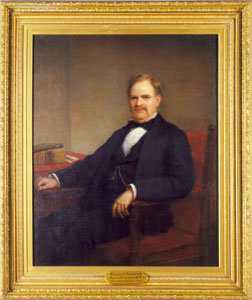Previously Assistant Secretary of the Treasury under Secretary George S. Boutwell, President Grant promoted William A. Richardson (1821 - 1896) to Secretary when Boutwell resigned. The postwar economy had expanded so quickly that commercial banks became nervous and began calling in their loans. As a result, in the

Sec. William A. Richardson
Richard Morrell Staigg
Oil on canvas
1880
63 7/8 x 54 x 4 1/8"
P.1881.6
summer of 1873 the money supply tightened drastically, causing a panic. Richardson responded by issuing $26 million in greenbacks to meet the demand. The legality of his action was doubtful, but Congress did not interfere and the crisis was eased. (Such cycles of expansion and panic continued for the next thirty years, and were the basis for the creation of the Federal Reserve in 1913).
In his last months in office Richardson became embroiled in the "Sanborn Incident." John Sanborn, hired by Richardson under a congressional act to recover unpaid taxes, had kept much of what he had collected. Congress investigated the matter, and through no direct involvement by Richardson, his removal was demanded. Grant responded by appointing Richardson to a position on the Massachusetts Court of Claims in 1874.
About the Artist
Born in Leeds, England in 1817, Richard Morrell Staigg (1817 - 1881) immigrated to this country in 1831 and first studied painting in Newport, Rhode Island with Jane Stuart, daughter of Gilbert Stuart. Staigg moved to Boston around 1840 to study further with Washington Allston, and spent most of his career in that city. Well versed in such diverse fields of painting as portraiture, miniatures, genre, and landscape, the National Academy of Design elected him a National Academician in 1881. Staigg's portrait of William A. Richardson, painted in 1880, was probably done from life.
Office of the Curator
All rights reserved. 2001